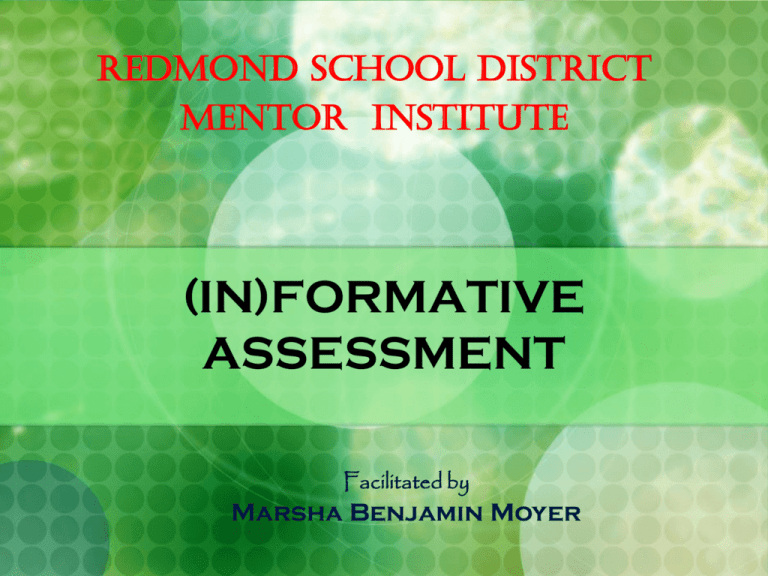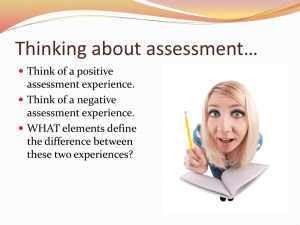
Redmond School District
Mentor Institute
(IN)FORMATIVE
ASSESSMENT
Facilitated by
Marsha Benjamin Moyer
Are You… ASSESSMENT SAVVY?
Skilled in gathering accurate
information about students
learning?
Using it effectively to
promote further learning?
Institute Objectives
Understand the various reasons as to why
assessment is essential in teaching/learning
Describe 3 types of assessments and
identify the purpose of each (why)
Identify assessment targets (what)
Explain various methods of
assessment (how)
Apply assessment information to
current teaching experience
FORMATIVE
ASSESSMENT…
refers to any number of ways that we can
uncover student ideas/knowledge about
concepts important to the unit being
taught (diagnostic) in order to adjust our
instruction to the needs of the students;
collecting evidence of understanding in
order to focus teaching and learning
HOW DO YOU ASSESS?
List some ways you typically assess
students in your classroom.
1.
2.
3.
4.
WHEN DO YOU ASSESS?
Traditionally, teachers have
assessed students at the end of
an instructional unit or sequence
However, when assessment
and instruction are interwoven,
both the students and the
teacher benefit
ASSESSMENT PROCESS
Summative
Assessment
Pre –
Assessment
(Assessment OF Learning)
Formative
Assessment
(Assessment FOR Learning)
PRE-ASSESSMENT
The purpose of pre-assessment is
to determine what students know
about a topic before it is taught.
Pre-assessment will help the teacher
determine flexible grouping patterns
and should be used regularly.
Pre-Assessment
Strategies
Checklist
Pre-test
KWL Charts
Graphic Organizers
Pre-test
Student Discussions
Student
Demonstrations
Student Products
Student Work Samples
Show of hands/EPR
(Every Pupil Response)
Standardized Test Data
Teacher Observation
Writing Prompts
Writing Samples
FORMATIVE
ASSESSMENT
Assessments FOR learning happens
while learning is still underway
These are assessments that:
are conducted throughout teaching and
learning to diagnose student needs
plan the next steps in instruction
provide students with feedback they can use
to improve the quality of their work
help students see and feel how they are in
control of their journey to success
FORMATIVE
ASSESSMENT
This Type of
Assessment
is NOT about
accountability…
it is about GETTING
BETTER!!
FORMATIVE
ASSESSMENT
Seven Strategies
WHERE AM I GOING?
1. Provide a clear and understandable vision of
the learning target
What Can Be Assessed?
ACHIEVEMENT TARGETS
Knowledge
Mastery
Reasoning
Proficiency
Performance
Skills
Ability to
Create Products
FORMATIVE
ASSESSMENT
Seven Strategies
WHERE AM I GOING?
2. Use examples and models of strong and
weak work
FORMATIVE
ASSESSMENT
Seven Strategies
WHERE AM I NOW?
3. Offer regular descriptive feedback.
4. Teach students to self-assess and set goals.
FORMATIVE
ASSESSMENT
Seven Strategies
HOW CAN I CLOSE THE GAP?
5. Design lessons to focus on one aspect of quality
at a time.
6. Teach students focused revision.
7. Engage students in self-reflection,
and let them keep track of and
share their learning.
Formative Assessment
Strategies
• Conference
•
• Cooperative Learning •
Activities
•
•
• Demonstrations
• Exit Card
• Graphic Organizers
• “I Learned” Statements •
•
• Interviews
•
• Journal Entry
•
• KWLs
•
Learning Logs
Oral Attitude Surveys
Oral Presentations
Peer Evaluations
Problem Solving
Activities
Products
Questioning
Quiz
Response Groups
Self-Evaluations
SUMMATIVE
ASSESSMENT
This type of
assessment is a
successful
end product
and/or the fulfilling of
the pre-stated
objective
SUMMATIVE
ASSESSMENT
A summative assessment/evaluation is
designed to:
provide information
make judgments about student
achievement at the end of a sequence of
instruction, (e.g., final drafts/attempts,
tests, exam, assignments, projects,
performances)
It is a means to determine a student’s
mastery and understanding of information,
skills, concepts, or processes.
Summative Assessment
Strategies
Unit Test
Performance Task
Product/Exhibit
Demonstration
Portfolio Review
The Assessment–Instruction
Process
Summative
Assessment
“making sure”
Pre –
Assessment
“finding out”
Formative
Assessment
“checking in” “feedback”
“student involvement”
What types of Assessment
Methods Can Be Used?
ASSESSMENT METHODS
Selected
Response
Extended Written
Response
Performance
Assessments
Personal
Communication
What types of Assessment
Methods Can Be Used?
ASSESSMENT METHODS
Selected
Response
Students select
the correct/best
response from
a list provided
Multiple choice, true/false, matching,
short answer, fill-in questions
What types of Assessment
Methods Can Be Used?
ASSESSMENT METHODS
Extended Written
Response
Students construct a written
answer in response
to a question or task
Compare …… Analyze…… Interpret….
Solve a problem and explain work… Describe in detail…
What types of Assessment
Methods Can Be Used?
ASSESSMENT METHODS
Assessment is based on
observing a performance/product
and making a judgment
Performance
Assessments
Performances:
*playing an instrument,
*carrying out steps in
an experiment
*speaking in a foreign language
*working productively
in a group
Products:
*term paper
*lab report
*work of art
What types of Assessment
Methods Can Be Used?
ASSESSMENT METHODS
*Responding to
journals/logs
*Asking questions
during instruction
*Interviewing students
in conferences
*Giving examinations
orally
Determine what a student
has learned through
personal interaction with them
Personal
Communication
Matching Assessment
Targets and Methods
Targets
Knowledge
Mastery
Reasoning
Proficiency
Skills
Ability to
Create Products
Selected
Response
Extended
Written
Response
Performance
Assessment
Match the assessments at
your table with the target
and method
Personal
Communication
Classroom Assessments
Some teachers
talk about:
LEARNING
Some teachers
talk about:
VERSUS
GRADES
Can these co-exist peacefully?
Should one receive emphasis over the other?
Conceptualizing the Domain
Based on evidence/research, “It’s not the
difference in curricula, it’s the difference
in teaching that really impacts student
achievement.”
1.
2.
TRUE
FALSE
Descriptive and specific feedback should
be provided to students
1. by the teacher
2. by other students
3. by both the teacher and other students
Descriptive and specific feedback should
be provided to students
1. by the teacher
2. by other students
3. by both the teacher and other students
http://youtu.be/W0oB82s2QPM
Formative Assessment-Take 1
Formative Assessment-Take 2
Formative Assessment-Take 3
Formative Assessment-Take 4
Formative Assessment-Take 5
http://youtu.be/0GOJdAXhteY
SOME FINAL THOUGHTS
Formative Assessment:
Refers to what happens on a daily basis in the
classroom
Provides teachers with information about specific
next instructional steps for students:
Assessment Drives Instruction.
Students know where they are at instructionally
and where they need to go
On-going assessment provides continual
feedback that helps students progress over time
(IN)FORMATIVE
ASSESSMENT
Redmond School District
November 2013
Human Scatterplot
• Teachers create x- and y-axis on floor and label
each
• Students place themselves on the graph based
on their own self-assessment
• Can also be done with post-its instead of people
• Gives a quick snapshot of student thinking and
confidence students have in their level of
understanding
3/10/2016
copyright www.brainybetty.com
2006 All Rights Reserved
44
Four Corners
• Used with challenging multiple choice questions
• Each corner of the classroom is labeled with a
letter, students move to the corner that matches
their choice
• Discuss their choice with other students in the
same corner
• One representative presents the ideas from their
corner
• Students may change sides of the room after
discussion
3/10/2016
copyright www.brainybetty.com
2006 All Rights Reserved
45
She was embarrassed
that she didn’t speak the
language well.
The store was across a
dangerous street.
Why didn’t Andrea go to the store?
She was nervous that she
would run into Emilio.
3/10/2016
She didn’t have enough
money to buy anything.
copyright www.brainybetty.com
2006 All Rights Reserved
46
Commit and Toss
• For brave teachers
• Teacher gives students a question
• Students write answer on paper, then crumple it
up
• Students toss the paper balls to other students
• Teacher calls on students to talk about the ideas
on the papers they caught
3/10/2016
copyright www.brainybetty.com
2006 All Rights Reserved
47
Agreement Circles*
• Teacher gives statement
• Students agree/disagree (agree forms
inner circle/ disagree forms outer circle)
• Inner and outer circles discuss the
statement
• Activates thinking and encourages
academic debate
3/10/2016
copyright www.brainybetty.com
2006 All Rights Reserved
48
Wipe Out!
• Students list 3 things they learned
• All students stand up
• One student reads list, everyone crosses
off common ideas
• Students sit down when all of their ideas
have been crossed off
3/10/2016
copyright www.brainybetty.com
2006 All Rights Reserved
49
Traffic Light
• Allows students to self-assess
• Can be used at any point during instruction
• Colors indicate full, partial, or minimal
understanding
3/10/2016
copyright www.brainybetty.com
2006 All Rights Reserved
50
Finish the Face
• Combines summarizing with metacognition
• Students reflect on their learning and
confidence level
• Easy to use for a quick sort of students
3/10/2016
copyright www.brainybetty.com
2006 All Rights Reserved
51
3/10/2016
copyright www.brainybetty.com
2006 All Rights Reserved
52
Problem
What I Know
Solve and
Label
Explain and
Justify
What I Need
to Find Out
3/10/2016
copyright www.brainybetty.com
2006 All Rights Reserved
53
3/10/2016
copyright www.brainybetty.com
2006 All Rights Reserved
54
On A Roll*
• Each table rolls a number cube
• Students at the table answer the question
that corresponds to the number rolled
• Can be used for several days over the
course of a topic of study
3/10/2016
copyright www.brainybetty.com
2006 All Rights Reserved
55
First Word/ Last Word Poems*
• Students create acrostic poems with
information they know about a topic
• First Word Acrostic Poems can be used to
pre-assess student understanding
• Last Word Acrostic Poems are used to
show what students have learned and
understand
3/10/2016
copyright www.brainybetty.com
2006 All Rights Reserved
56
EROSION
Eats away at land
Rain can cause erosion
Occasionally wind causes erosion
Steps can be taken to prevent erosion
including planting trees
Is also known as weathering
Oceans cause erosion that is easy to see
Never is matter lost, it’s just moved to a new
place
3/10/2016
copyright www.brainybetty.com
2006 All Rights Reserved
57
Most Valuable Point (MVP)*
• Can be used as Ticket-Out-The-Door
• Students list
– 3 new ideas
– 2 connections
– 1 question
– 1-sentence summary
3/10/2016
copyright www.brainybetty.com
2006 All Rights Reserved
58
3 Pointer
(3 New Things You Learned)
*________________________________________
_________________________________________
*________________________________________
_________________________________________
*________________________________________
_________________________________________
2 Pointer
(2 Connections You Can Make)
*________________________________________
_________________________________________
*________________________________________
_________________________________________
Foul Shot
(What Question Do You Have?)
*________________________________________
_________________________________________
3/10/2016
copyright www.brainybetty.com
2006 All Rights Reserved
59




